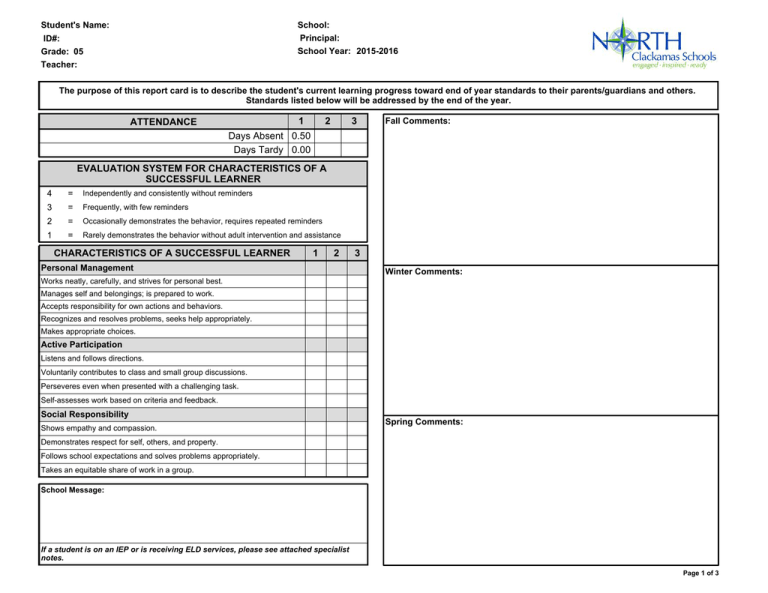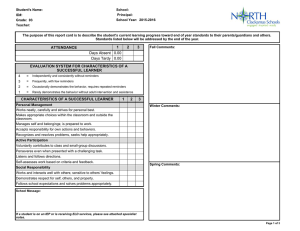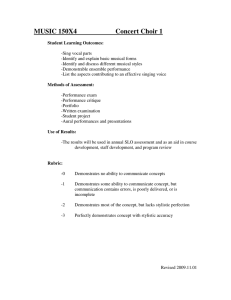School: Student's Name: Principal: ID#:
advertisement

Student's Name: School: Principal: School Year: 2015-2016 ID#: Grade: 05 Teacher: The purpose of this report card is to describe the student's current learning progress toward end of year standards to their parents/guardians and others. Standards listed below will be addressed by the end of the year. 1 ATTENDANCE 2 3 Fall Comments: Days Absent 0.50 Days Tardy 0.00 EVALUATION SYSTEM FOR CHARACTERISTICS OF A SUCCESSFUL LEARNER 4 = Independently and consistently without reminders 3 = Frequently, with few reminders 2 = Occasionally demonstrates the behavior, requires repeated reminders 1 = Rarely demonstrates the behavior without adult intervention and assistance CHARACTERISTICS OF A SUCCESSFUL LEARNER 1 2 Personal Management 3 Winter Comments: Works neatly, carefully, and strives for personal best. Manages self and belongings; is prepared to work. Accepts responsibility for own actions and behaviors. Recognizes and resolves problems, seeks help appropriately. Makes appropriate choices. Active Participation Listens and follows directions. Voluntarily contributes to class and small group discussions. Perseveres even when presented with a challenging task. Self-assesses work based on criteria and feedback. Social Responsibility Shows empathy and compassion. Spring Comments: Demonstrates respect for self, others, and property. Follows school expectations and solves problems appropriately. Takes an equitable share of work in a group. School Message: If a student is on an IEP or is receiving ELD services, please see attached specialist notes. Page 1 of 3 Student's Name: School: Principal: School Year: 2015-2016 ID#: Grade: 05 Teacher: PROFICIENCY SYSTEM FOR CONTENT AREAS: E - EXCEEDING GRADE LEVEL STANDARDS: The student exceeds end of year grade level expectations by independently applying and utilizing concepts and skills. M - MEETING GRADE LEVEL STANDARDS: The student consistently meets end of year grade level expectations for concepts and skills. PROGRESSING TOWARD GRADE LEVEL STANDARDS: The student is making expected progress toward end of year grade level expectations or demonstrates basic but inconsistent P - application of essential concepts and skills. NOT MAKING EXPECTED PROGRESS TOWARD GRADE LEVEL STANDARDS: The student demonstrates limited understanding of end of year standards and needs more support to N - develop concepts and skills. NA - NOT ASSESSED: Indicates that standards were not assessed this grading period. LANGUAGE AND LITERACY STANDARDS Reading 1 2 3 1 2 3 The student can read fifth grade level texts orally with accuracy and fluency. 1 2 3 The student can compare and contrast two or more characters, settings, or events in a story. The student’s writing demonstrates appropriate use of grade level conventions, including correct verb tenses, complex use of commas, and quotations. The student can compare how stories, in the same genre, can communicate the same theme. The student can use conventional spelling patterns, spell grade level appropriate words correctly, and consult reference materials as needed to check and correct spelling. The student can summarize informational text including two or more main ideas. The student can analyze multiple accounts of the same event or topic, noting important similarities and differences in the point of view they represent. The student can explain how an author uses reasons and evidence to support main ideas in text. 1 2 3 1 2 3 1 2 3 The student uses precise language and content specific vocabulary to inform about or explain the topic. Conventions and Grammar The student can quote from a text and draw inferences from informational text. 3 The student's writing has multiple paragraphs, including an effectively developed introduction, logically ordered events or examples, transitions (e.g., words, phrases, and clauses), and an effectively developed conclusion. The student can quote from a text and draw inferences from literature. Informational Text 2 The student can use text quotations, dialogue, concrete or sensory details, supporting evidence, facts and reasons, with effective pacing, to support their topic. The student can use strategies to determine meaning of unknown words and content area vocabulary. Literature 1 The student can write about a clear and focused topic. The student can read and comprehend fifth grade level texts. Foundational Skills Writing: Text Types and Purposes 1 2 3 The student can use a variety of simple, compound, and complex sentences (avoiding fragments and run-ons) appropriate to audience and purpose. Technology The student can use digital tools, including the Internet, to produce and publish writing as well as to interact and collaborate with others. The student can type a minimum of two pages in a single sitting. Speaking and Listening: Comprehension, Collaboration, and Presentation of Knowledge and Ideas The student can engage effectively in structured discussions; paraphrase and identify evidence from a text or information presented. The student can report orally on a topic, using appropriate facts and relevant descriptive details. The presentation is organized in a manner that is suitable to the audience, adding additional media as appropriate. Page 2 of 3 Student's Name: ID#: Grade: 05 Teacher: School: Principal: School Year: 2015-2016 SCIENCE MATHEMATICS STANDARDS Math Problem Solving 1 2 3 MAKING SENSE OF THE TASK: The student understands a word problem and can identify one or more mathematical strategies that will lead to a solution. HEALTH ART 1 2 3 Active Participation (Characteristics of a Successful Learner) 1 2 3 2 3 1 2 3 1 2 3 1 2 3 1 2 3 1 2 3 The student actively participates in musical activities. Knowledge and Skills (Proficiency System) The student can multiply and divide numbers using an algorithm and models. The student demonstrates musical knowledge of written rhythmic and staff notation, expressive symbols, and instrument identification. The student can add and subtract decimals to the hundredths place using models. The student demonstrates musical skllls through a variety of musical activities. 1 2 3 The student can use equivalent fractions as a strategy to add and subtract fractions with unlike denominators. PHYSICAL EDUCATION Self Management and Social Responsibility (Characteristics of a Successful Learner) The student can use models to multiply and divide fractions. The student actively participates in physical education activities. 1 2 3 The student can use a line plot to display data and solve problems. The students demonstrates responsible behavior and respect for differences among people during physical activities. The student can find the volume of three-dimensional figures. Movement/Motor Skills (Proficiency System) The student can classify two-dimensional figures into categories based on their characteristics. 1 The student demonstrates skills taught in class. The student can read, write, compare, and round decimals to the thousandths place. The student can graph points on the coordinate plane to solve mathematical problems. 3 MUSIC The student understands and accurately uses parentheses, brackets, or braces in equations. Geometry 2 The student shows an understanding of healthy living and prevention of disease, alcohol, tobacco and other drug use. REFLECTING AND EVALUATING: The student can evaluate the answer and determine if it makes sense. Measurement and Data 1 The student shows an understanding of civics and government, economics, geography, and history. ACCURACY: The student finds the correct solution and shows work that supports the answer. Number and Operations: Fractions 3 The student can plan and conduct an investigation to make predictions or test hypotheses. SOCIAL SCIENCE COMMUNICATING REASONING: The student can clearly communicate mathematical thinking using appropriate mathematical vocabulary. Number and Operations in Base Ten 2 The student can choose appropriate methods to collect, analyze, and report data from observations. REPRESENTING AND SOLVING THE TASK: The student selects and uses models, pictures, diagrams, and/or symbols to represent and solve the task. Operations and Algebraic Thinking 1 1 2 3 The student demonstrates motor skills in a variety of physical activities. PE Skills Taught Fall: PE Skills Taught Winter: PE Skills Taught Spring: Page 3 of 3




